RD2: A Majestic Prologue (Outlaws From The West)
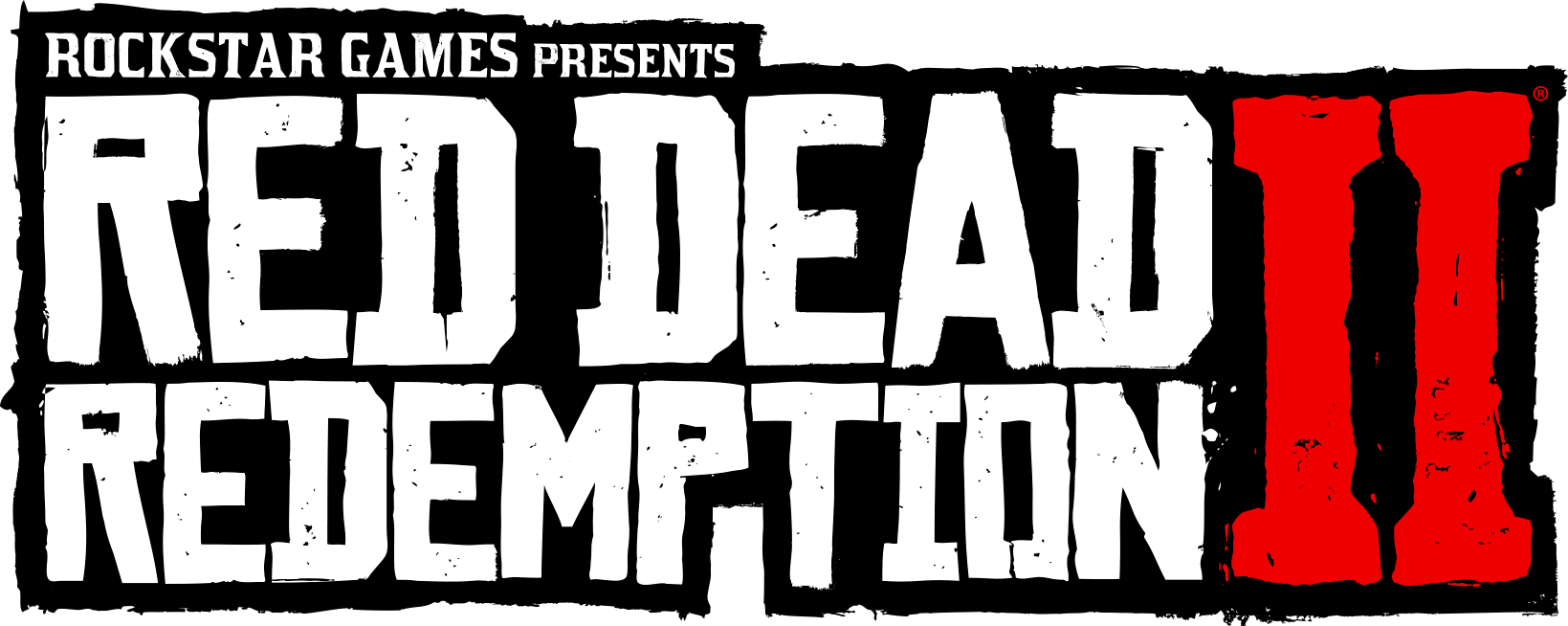
MGR is launching a new series of streams dedicated to the storytelling of Red Dead Redemption 2! Join me weekly on YouTube for a new live stream of the game and a fresh exploration of the story behind Rockstars hit title. The streaming schedule is posted on the channel's community page and Twitter for your kind consideration.

MattGoesRogue is dedicated to exploring storytelling in various forms of interactive entertainment, including video games and tabletop roleplaying games. Subscribe to my Youtube channel for more videos about RD2, and follow my socials for regular updates.
MattGoesRogue Youtube Channel | Twitter | Instagram

Chapter 1: Colter
Following an unsuccessful robbery in Blackwater and the Van der Linde gang's subsequent escape into a snowstorm in Ambarino, the gang is barely holding on, with Davey Callander severely wounded and on the brink of death. Arthur Morgan arrives and informs Dutch about an abandoned settlement where they can take shelter for the time being. As the gang arrives, they rush Davey into a cabin, where he ultimately succumbs to his wounds. In response, Dutch delivers a motivational speech, urging the gang to stay resilient and transform Colter into a temporary camp. He then informs the gang that he and Arthur will go scouting for food and supplies before leaving the cabin.
Source: Red Dead Redemption 2 Wiki

List of Missions
The video is using the following timestamps:
- "Outlaws from the West" 0:00
- "Enter, Pursued by a Memory" 23:50
- "Old Friends" 42:00
- "The Aftermath of Genesis" 1:13:00
- "Who the Hell is Leviticus Cornwall?" 1:33:27

Prologue and Storytelling
Spoiler Disclaimer: In this section, we will look at the key narrative elements of this specific game segment. While I am trying not to give away too many surprises, this section is likely to include a few spoilers - so, if you have not played RD2 yet, please do and experience this amazing title for yourself first (it's worth all the hours, sweat and tears you will invest into it).
In this opening chapter, RD2 introduces the key characters of the game, including Arthur, Dutch, John (RD1), Micah, and the rest of the gang. They are fleeing from the misfortune they encountered at Blackwater. The narrative also introduces the core game mechanics that will be at play throughout the game, allowing the player to practice basic actions, movements, dialogue interactions, etc. This is typical at the prologue stage of most contemporary games.
What sets RD2 apart from most games is the meticulous crafting of tutorial activities operating from the context of the prologue narrative. This set of training activities is deeply anchored in the core motivations of the protagonists and the survival needs of the group, now stranded in a mining village in the mountains.
An excellent example of this gameplay 'practice + narrative' combo is the bow tutorial where Charles's burned hand necessitates Arthur to learn how to use it for a hunt. Another relevant instance is the tutorial on how to skin a deer, where the butcher supervises Arthur and mentions that selling animal skins can be a relevant source of income when needed. However, Arthur dismisses this idea, expressing his sole desire to escape from that 'damn mountain,' closing the dialogue with wit.
Integrating gameplay mechanics while maintaining authentic character traits and perspectives, even if the information is dismissed by the character at play, is an absolute stroke of genius as it nurtures the integration of game practice as part of the narrative itself. It's a very elegant way for the player to learn the ropes while getting the story moving forward.

Character Introduction
Chapter 1: Colter sets the scene for the Van der Linde gang, establishes the stakes of the story, and defines the core relationships of this tale (rivalry, friendship, family units, romantic connections, duty-bounded commitments, etc). This has the effect of establishing the key figures of this epic Western tapestry, starting with...
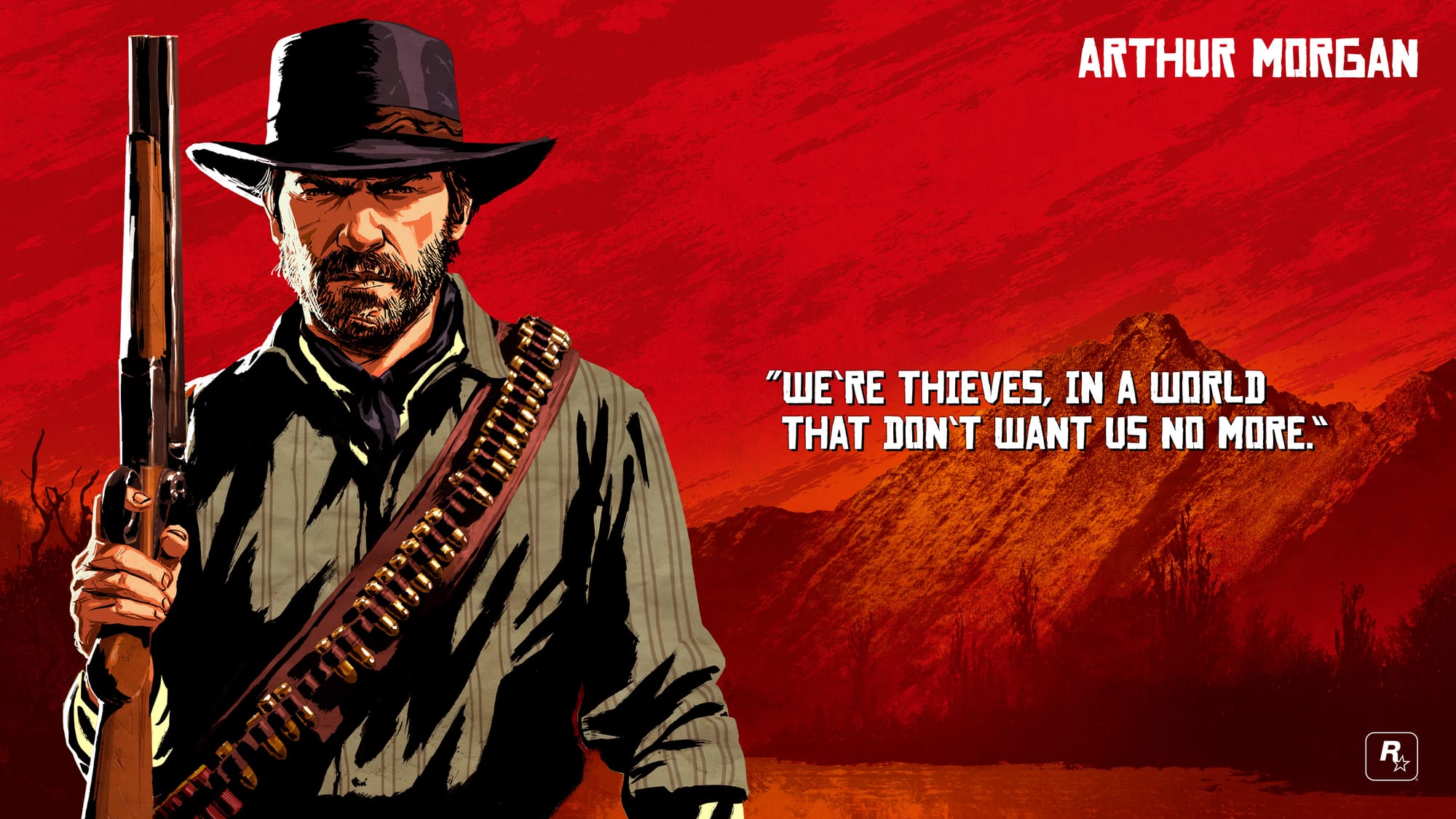
We meet our rugged Westerner on the run with the members of his community, caught in the storm of an icy blizzard, lost in the mountains. Helping to bring the people of his gang to safety, he supports and enforces the plans of Dutch van der Linde (our charismatic gang leader), acting as his loyal right-hand man.
While we know very little about Arthur at this stage, we become aware he is a valued and respected member of the community - a straight-up guy amongst outlaws, gifted with wit and a dry sense of humor. He is given a bed when others sleep on the floor; he is clearly not at the bottom of the food chain, and his status of enforcer of choice might come with a few extra tin cans.
Arthur also appears to be a man with opinions of his own, and someone who knows when best to voice them, especially when addressing Dutch. He is cautious and somewhat conservative toward violence as a first solution to all problems, but he knows how to get things done (he is a very able shooter, rider, and survivor).
On his way back from the deer hunt, Arthur opens up to Charles about the fact he has known Dutch for over 20 years. Dutch 'saved him' just like most of the other gang members over the years, and he taught him how to read. Arthur has learned 'a thing or two' from him during his youth, - a depth of gratitude certainly runs deep for Dutch. For Arthur, a plan going wrong is just part of life (i.e Blackwater), and Dutch needs all the support and loyalty of his people to help him lift his community out of austerity - Dutch has always looked after his own "That's why we need to stick by him through this..."
While other aspects of his past remain elusive at this stage, and admittedly, the West is a harsh world where one must often break bones to survive, Arthur appears to have a righteous spirit. He is capable of empathy, compassion, gratitude and companionship. Moreover, Arthur seems to be a man of sober ambitions carrying with him the values of a generation of countrymen enjoying the simple pleasure of a life in the open air. His attempt to reassure Sadie Alder also seems to imply he is not very in touch with his softer side - he comes across a little gauche, uncomfortable, but not less touching in his attention.
For reasons we still ignore, Arthur wasn't involved in the preluded incident of Blackwater, and he tries to piece together the events of this misfortune with the other members of the crew - using most horse rides to ask questions about this fateful event.

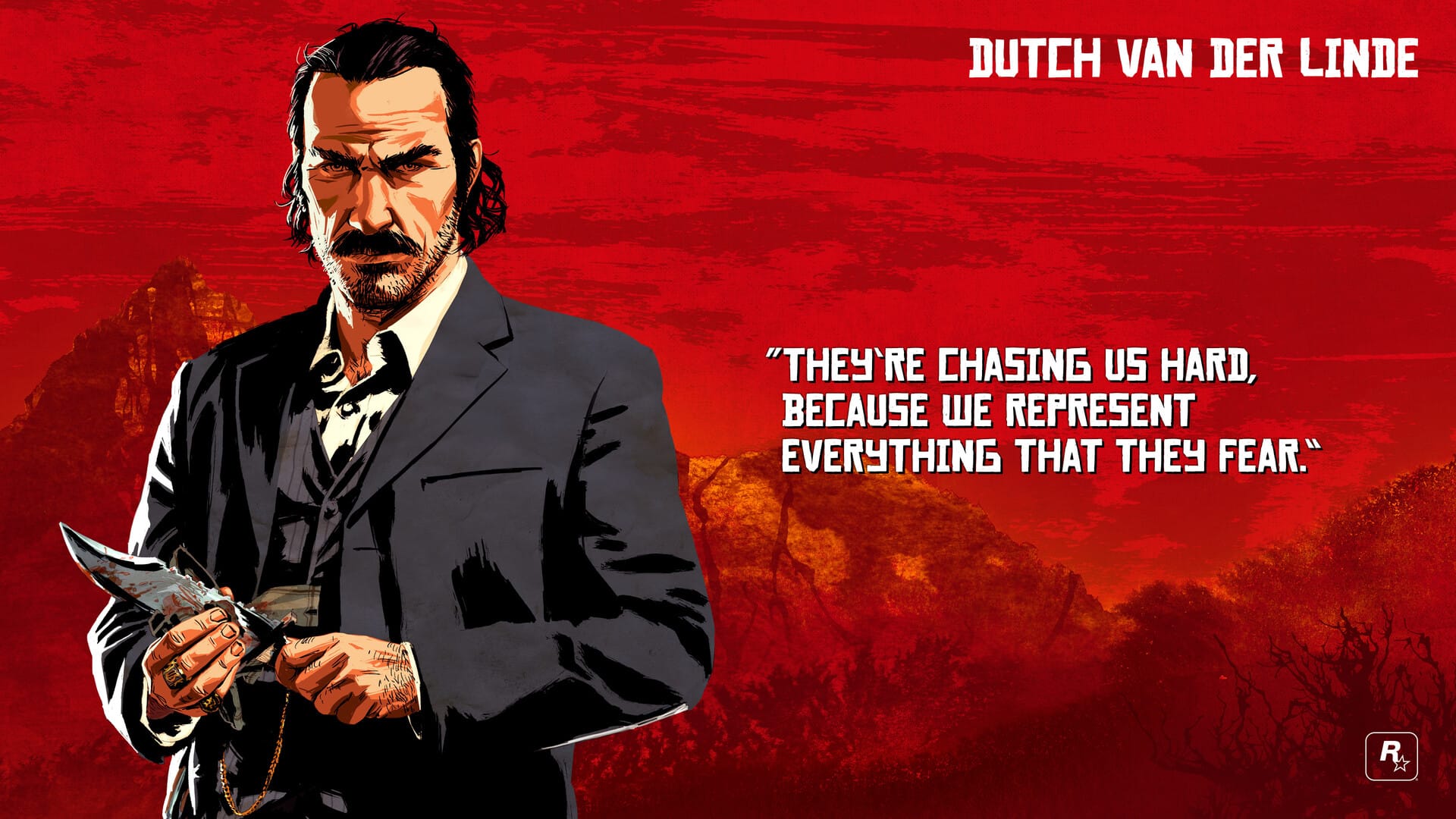
The character of Dutch is introduced after the event of Blackwater, leading his community of outlaws in exile in the snowy mountains. After finding a resting place in a deserted mining village, Dutch is addressing the recent losses of the gang - and those who left in hope for a better future. While morale is low, he asks his community to continue trusting him and to invest their efforts to help him build a brighter future for all.
Do you doubt me, Arthur? Of course not, Dutch.
Dutch's character embodies the charisma and leadership qualities to what can only be described as the love child of Negan (The Walking Dead) and William "Bill the Butcher" Cutting (Gangs of New York). He is a sophisticated man leader, charming, the kind of guy that 'does the talking' more than the shooting (although he is pretty good at it too). He expresses a sense of responsibility towards 'his people' while following very personal motivations and ambitions- putting the lives of those he claims to care for at great risks.
"Dutch being Dutch, he is busy making plans and... Dutch being Dutch, these plans involve robberies and dreams." - Arthur Morgan
Dutch's early red flag is a relentless need to ensure the loyalty of his team and the necessity to diffuse any doubt about his authority - starting with his most loyal enforcer, Arthur. He is gifted with a certain sense of narcissism and unbridled ambition for respectability and status in the eye of society.
Taking care of Arthur during a time of necessity or vulnerability ('Dutch saved me') is a powerful opportunity for a leader of his kind to create unquestionable alliance - the very leverage he needs to enforce his plans and to pursue his own interests.
Dutch governance style is authoritative dressed as a servant leadership. He is a man with high emotional intelligence who understands people's dreams, motivations and power dynamics.

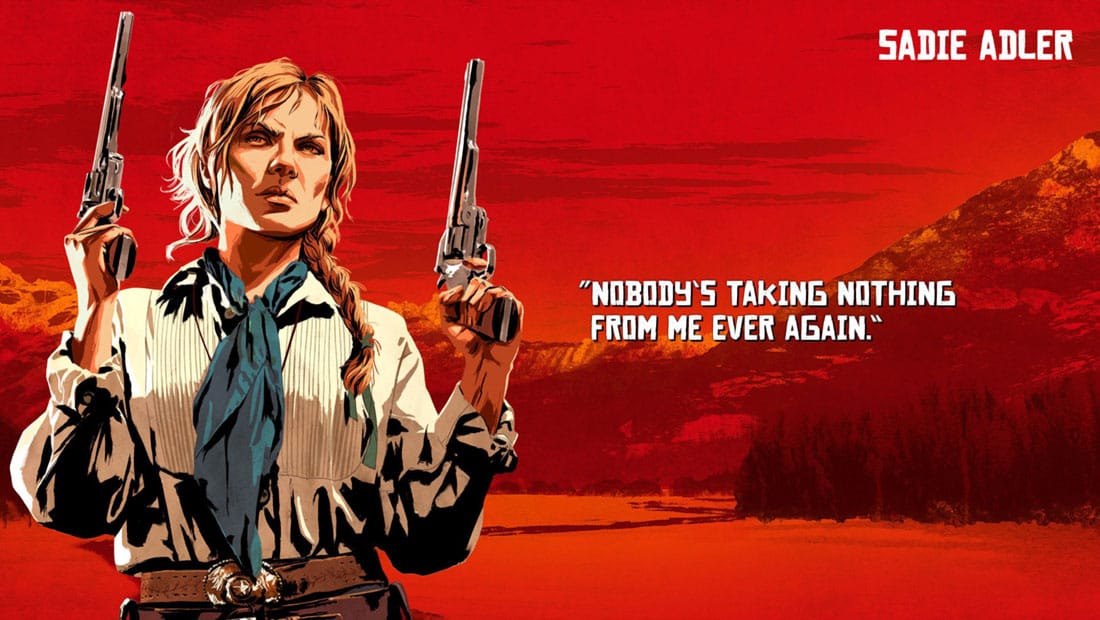
Sadie Adler is also a prominent character in this introduction - in fact, I will go to the extent of saying this introduction is as much about the Van der Linde gang as it is about the origin story of Sadie.
In the 'Outlaws From The West' sub-chapter, Dutch, Arthur, and Micah are approaching a house, only to be met by the O'Driscoll Boys. Waiting in hiding, Micah finds the body of a dead man in a nearby chariot. After the inevitable tutorial opportunity of Arthur's fist shootout and beat-to-get-intel session in the nearest barn, Arthur's attention is caught by the scream of a woman coming from the house. He enters and finds Sadie pointing a knife at him and the rest of the crew. Micah just found her hiding in the cellar, and thinks she is an O'Driscoll. Dutch tries to persuade him otherwise, but Micah leaps forward in a an attempt to catch Sadie - flipping the large table standing between them on the ground. As the table smashes on the wooden floor, an oil lantern shatters and spreads flames across the room.
Sadie has just witnessed the murder of her husband; she is traumatized, full of rage, and lost for words. Dutch eventually de-escalates the situation, and the gang leaves in haste as the fire consumes the entire house. Dutch decides to take her to the miner's village and to care for her. Arthur attempts to comfort her by saying -'Ma'am, we are bad men, but we are not them.'
This tragic night will propel Sadie to become one of the most iconic female characters of RD2, as she is about to begin the most transformative chapter of her life as a soon-to-be gunslinger. The unrooting of her life is also very significant of the collateral damage imposed by the crossfire of the O'Driscoll VS Van der Linde feud. If one gang took her husband, the other took her house - she has lost everything.
Sadie is now a destitute, vulnerable, isolated, broke, and angry widow - the perfect foundation for a future life dedicated to revenge and crime. Now welcomed under the warm wings of Dutch van Linder, she will become a Calamity Jane in no time.

Narrative Devices
This prologue needs to pack a lot of information in a short amount of time, not only to inform the player about the narrative context of the game, but also to hook them with an intrigue worthy of their attention as well as to get them involved in gameplay as early as possible.
Similarly, this foundational chapter needs to set the edges of the narrative structure, tone, pace, format, and expectations for everything that will follow. It's, therefore, one of the most info-heavy and linear chapters of the game, delivering exposition and story threads via various narrative techniques, including dialogue and voice-over, cut-scenes, foreshadowing threats, elements of mystery and more...
- Opening Text Card
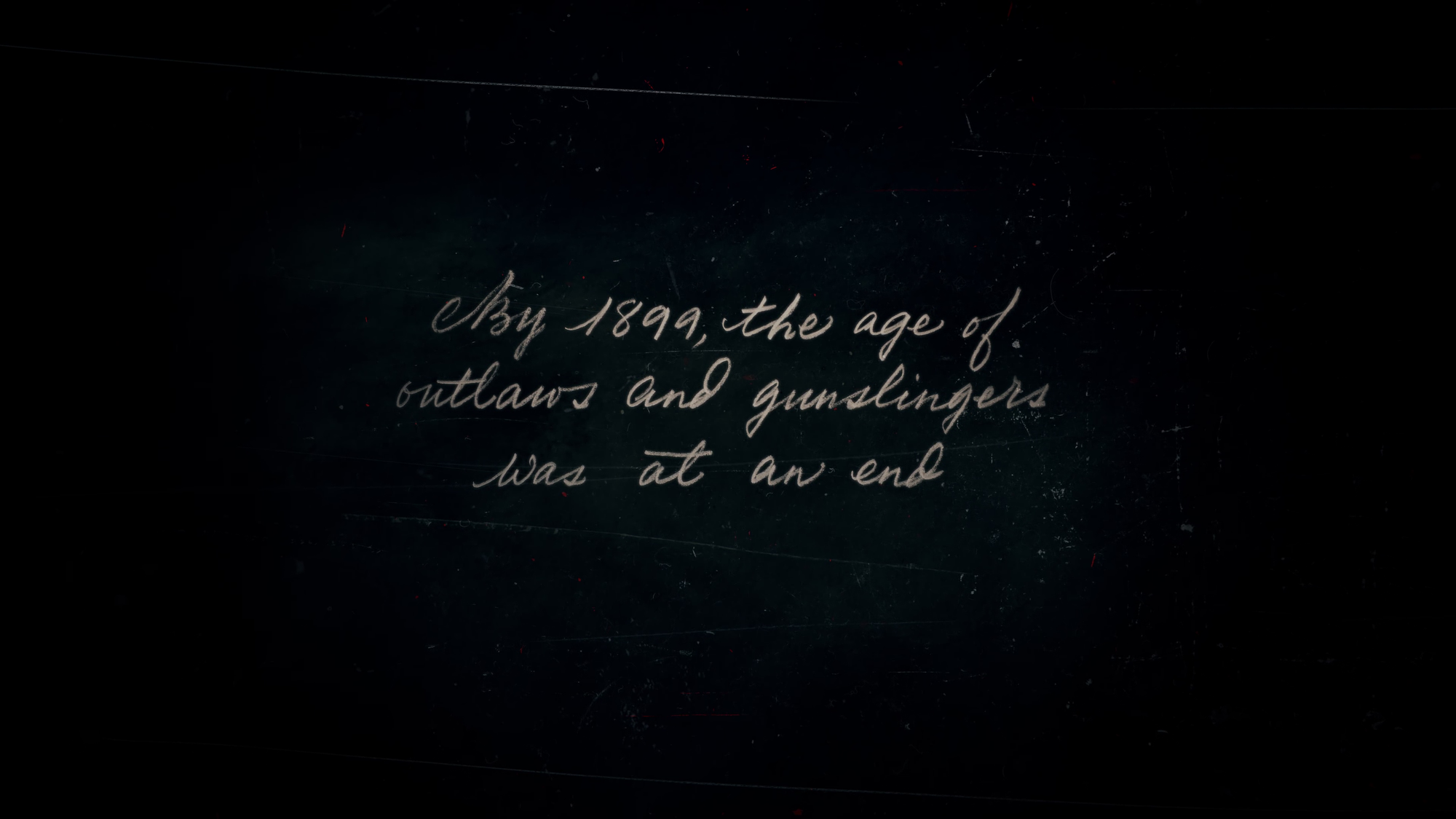
This contextual text is generally used to establish the socio-political backdrop of a game or film. It informs the player about the era when the story takes place and foreshadows a sense of danger for the main character or his kind.
The most important aspect of opening text cards is what they are directly edited with, as they create a contrasted introduction about the protagonists of the story yet to be told - more often than not showing the heroe (subject of the opening text card) in a vulnerable situation at the tail end of a previous heist, quest or mission. The opening text card sets the stage, the scene and the stakes for what is about to happen - our unlikely hero can now step in.
This particular opening text card is cut with a scene showing a tail of heavy wooden wagons struggling to carve their ways in the thick snow of a mountain ridge, battered by a blinding snowstorm. A gang member reaches the leading wagon to indicate one of them is dying at the back, and they need to stop. Dutch indicates that Arthur is already ahead on the lookout for a place to stop. His nearest companion (Hosea Matthew) insists they will ALL die if they don't stop soon. The environment is clearly hostile, and we meet the gang at their lowest point - lost, exposed to the elements, dealing with the imminent death of a community member, desperate.
Hosea continues and says:
I am just hoping the law got lost as much as we did.
At this point, it's clear this community is a group of outlaws in exile.
Standing from historical distance (as the date is cited in the opening text card) we are given to experience the hollowing sentiment RD2 is somewhat fated in blood and sorrow, as if we were revisiting a story knowing the ending for its cover onward. It's not so much a matter of 'what' when you are an active contributor to the cycle of violence, but a matter of 'how' and 'when' - and if there is a slim chance to escape this spirale in order to build a better life.
This sentiment was previously shared by the majestic 'Assasination of Jessie James by the Coward Robert Ford' which gives away the narrative outcome of the film so we can focus on how we got there and the relationship between the two poster characters. Ultimately, this has for effect to focus closer on the individuals and their circumstances, their sense of values and morality, and who they could have been given the option of a better existance.
Another relevant element of this opening text card is the notion of change, the end of self-administered justice by gangs claiming authority on lands and city districts, and the beginning of a new century driven by progress and the standardisation of legal doctrine. It's the end of the american pioneering age and the prologue of modern America led by innovation and the emergence of the first industries.
As such, Arthur begins the story as an endangered species - he is both a prey for law enforcers, and a prey for progress in a fast-moving society. Will he survive the hunting of his kind? Will he adapt to the new world? And more importantly maybe,what kind of person will he become along the way? Will he lose his humanity in the crossfire of rivalry and revenge, or will he find solace in leading a more righteous life. Only the next 80 hours will tell.
- Cut-Scenes / Cinematics
The prologue uses cut-scenes to establish the landscape and locales, to distill exposition through dialogue and voice-over, leads us to witness tension between the members of the gang, and helps us jump in time 'a few days later'. These cut-scene are key contributors to how the story of the game is told to the player, also allowing more subtle emotions to peer through - such as shyness, regrets, affection, doubts. Emotions that would necessitate a close up or a longer pause on screen.
Admitably, they are active agents of the linearity of the narrative as they often bookend the gameplay validating how the game is intended to be played - but, they also reflect the player's agency by featuring details, behaviours, character look and clothing styles, and the display of alternative endings based on the player's decisions throughout the game.
The directing style, editing, soundtrack, and acting performance are outstanding and are a keys contributor of notoriety of the game - even to this day. RD2 includes over 16 hours of cut-scenes (that's about the length of four feature films). See full cast details is available here https://www.imdb.com/title/tt6161168/
- Foreshadowing
Foreshadowing is a narrative device used to build anticipation, tension and suspense regarding the outcome of a scene (or story as a whole). It was overly well-used by Alfred Hitchcock, providing information to the audience that the main character doesn't have - it's generally refering to the presence of an imminent threat or danger. This segment of RD2 makes extensive use of foreshadowing; here are the most notable examples:
- The Opening Text Card, as discussed earlier
- The body of Mr. Adler found in the chariot indicates something is not right. Whoever is living in this house is capable of violent atrocities. Meanwhile Dutch knocks at the door and engages in small talks with the owner. What could go wrong? Your danger-sense is confirmed when the game prompts you to protect him and to fire your repeater.
- The Future of Sadie Alder. She now shares the same motivations as Dutch towards the O'Driscolls. Surviving under the good care of Dutch, it makes no doubt her rage and trauma will be put to good use. It's easy to anticipate the future of Sadie at this point. Mrs Adler will also represent a polarized version of Arthur, showing a version of who he could have become should he make other choices. Keep an eye out for her.
- Omission
Omission is a narrative device that focuses on what is missing - it's comparable to the notion of negative space in architecture. In games or films, it generally relates to a character missing from the story such as a missing parental figure, someone we are not allowed to speak the name, or an event anchored in a traumatic situation generally referred as 'That day.' This has the effect of catching the attention of the player and makes them want to know more about this teasing mystery. The notion of omission is very strong and incredibly practical in this segment of the game; here are a few examples:
- What happened in Blackwater - Dutch is referencing the events of Blackwater in a very elusive way. When Arthur asks for more details, he simply says 'You were not there. That's what happened'. Yet, we know it went wrong, and it's very much the reason behind the exile of the gang. This situation also raises the question - if Arthur wasn't there, then where was he? The current segment doesn't answer this - maybe it will be answered at a later time.
- Arthur and Dutch's Untold History - Dutch is an educated man and refers to his gang members with 'Mr.' and 'Mrs.' However, he seems to refer to Arthur as Arthur (with the odd 'Mr. Morgan' in a group setting) - this tends to indicate a specific keenship, a relation of proximity, a long friendship, family bounds, or a past connected by shared experiences. Dutch is deeply invested in Arthur to agree and approve of his plans, and to reaffirm his trust towards him and his leadership - it feels coercive, and this expectation of loyalty in principle is deeply rooted in the reciprocity of untold events - Arthur has a debt towards Dutch. At the end of the segment, Arthur mentions he has been on Dutch's side for nearly 20 years. Dutch saved him (circumstances untold) and taught him to read - this would induce a high level of loyalty for someone who values honor and principles as much as Arthur. It's clear from this point that Arthur's inner conflict will be at the heart of the 'Loyalty Vs Morality' opposition. I have no doubt more details about their history will emerge in the next sessions.
- The Killing of Mr. Adler - In anticipation of the killing of the O'Driscoll Boys, Micah finds the murdered body of Mr. Adler (as mentioned above). The investigation will show he was certainly killed in the house (I mean, look at the floorboards, what a mess!). Yet, we don't know what triggered this conflict and the relationship of the Adlers with the O'Driscoll Boys. All we know is that 'they came 3 days ago'. Sadie is too shocked to tell more at this stage, which may raise legitimate suspicions - Can Sadie be trusted? Is Alder her real name? Will she be a blessing to the gang, or a lesson for all to remember?
- That Priest Guy - One last, and curious, omission refers to the disapproving comment of Arthur towards the character tending to John's needs. He clearly has an issue with this character or his belief system. We don't know where this is coming from, but it creates an appreciation for past discords amongst gang members and makes us question Arthur's belief system. We might hear more about this soon.
- Travel Exposition
RD2 makes great use of horse riding travels. While fast travel options will be available in the next sections of the game, the game uses the opportunity of various journeys to funnel exposition and backstories during low intensity gameplay. This will generally happen when Arthur rides with one or more gang members.
During his rides, Arthur asks more about Blackwater, opens up about his past with Dutch, prepares an excuse for John to reduce the anxiety of his fellow gang members, and more.
This technique is a very clever narrative choice that gives the player the time and space to integrate new information about Arthur and the other characters, past events, and the tales of the gang while enjoying the beautiful scenery of the game.
This narrative device is borrowed from TTRPG travel mechanics, offering players the opportunity to roleplay and to share more about their characters in between two locations of interest.
6 - Pathetic Fallacy
Pathetic fallacy is a specific type of personification that attributes emotions to aspects of nature to reflect or foreshadow the emotional states of a character or, more broadly, the narrative's tone. This device acts as an impressionistic canvas, allowing the sentiments of characters to be externalized and communicated visually to the audience.
This tool is used extensively in RD2, employing dynamic weather, seasonal changes, landscapes and set pieces to coincide with key narrative moments, enhancing the emotional impact of the story. Pathetic fallacy can also include time of day, objects, lighting conditions, material conditions, and animals to echo the contemplation of untold human emotion.
This tool is one of my favorite 'magic tricks,' as its modus operandi (way of working) is almost invisible. It's not something you can easily see, but rather feel - like the aura of a moment. It's a very poetic and powerful device to use, and one that leaves the audience in a deep feeling of nostalgia, joyful contemplation, an increased level of fear or apprehension, or a comforting feeling of hope in a world in decay.
The Blizzard
The blizzard storm in the middle of the month of May, is one of them. This storm is a dramatic reflection of the gang's tourment, feeling blind and lost, now seeking safety. The blizzard acts as an external manifestation of their emotional condition.
The Deserted Mining Village
Same approach here. The deserted village is used a dramatic canva to re-enforce the dreadfull feeling of abandon, despair and decay experienced by the gang. This also play on a foreshadowing level as you could what happened to this village and its inhabitants... and if the gang members are in a threatning environment. The overall sentiment is unsettling making a great use of decor to depit the very condition of the gang.

Conclusion
This short prologue sets the tone of the game as a Hollywood super-production would, using narrative tools borrowed from the silver screen in ways that not only propel the tale of Arthur on dangerous tracks, but also educates the player about the interactive possibilities of gameplay within the context of the narrative.
It's needless to say the prologue of RD2 is one of the best crafted game introduction there is, as well as the most appealing promise for 80 hours of gameplay driven by character development, conflict, suspense, action, exploration, mysteries, and the questioning of the relevance when witnessing a world in constant change.
Don't miss on the next episode of RD2 by subscribing to my channel https://www.youtube.com/channel/UCI3WDbFwHW4xDn24YOdPfxw

ESRB Rating: RD2 is rated M for Mature.
PEGI Rating: This game has received a PEGI 18 rating due to scripted graphic violence and other mature topics within the fictitious context of gameplay. While violent behavior is a component of the game, it is not its sole focus. Themes, topics, character actions, and behaviors should be considered within the fictitious context of the game only. This content is listed as 'not for children' and may be subject to further age restrictions as per YouTube policies and terms of service.
Copyright Disclaimer: Rockstar Games, Inc. ©2005-2019. Rockstar Games, Red Dead Redemption, R*, Redemption, Red Dead, Dead Eye are trademarks/logos/copyrights of Take-Two Interactive. Dolby and the Double-D symbols are trademarks of Dolby Laboratories. The ratings icon is a trademark of the Entertainment Software Association. All other marks and trademarks are properties of their respective owners. Artwork and pictures featured in this article are propreties of Rockstar Games. All rights reserved. This stream was recorded without music to prevent any copyright strikes or copyright claims. RD2 has an amazing soundtrack, and I recommend playing the game with it, obviously.
This stream and article is honoring the terms of the Policy on Posting Copyrighted Rockstar Games Material - for any takedown request or complains please contact Matt at contact [at] mattgoesrogue.com

Featured and mentioned in this session: Arthur Morgan, Dutch, Sadie Alder, John, Mihca, Davey Callander, Negan, Blackwater, Grizzly Mountains, Abandoned mining town, Ambarino, Colter (temporary camp), Failed robbery, Gang fleeing from Blackwater, Scouting for food and supplies, Loyalty and support, Power dynamic, Threatening and hostile world, Core game mechanics, Tutorial activities, Character motivations, Dark past, Stranded in a mining village, Blizzard

MattGoesRogue Youtube Channel | Twitter | Instagram
